 W
WMarine debris, also known as marine litter, is human-created waste that has deliberately or accidentally been released in a sea or ocean. Floating oceanic debris tends to accumulate at the center of gyres and on coastlines, frequently washing aground, when it is known as beach litter or tidewrack. Deliberate disposal of wastes at sea is called ocean dumping. Naturally occurring debris, such as driftwood, are also present.
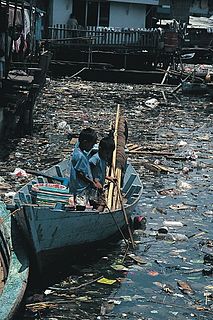 W
WMarine pollution occurs when harmful effects result from the entry into the ocean of chemicals, particles, industrial, agricultural and residential waste, noise, or the spread of invasive organisms. Eighty percent of marine pollution comes from land. Air pollution is also a contributing factor by carrying off iron, carbonic acid, nitrogen, silicon, sulfur, pesticides or dust particles into the ocean. Land and air pollution have proven to be harmful to marine life and its habitats.
 W
WThe Act to Prevent Pollution from Ships is a United States law that implements the provisions of MARPOL and the annexes to which the United States is a party. The most recent U.S. action concerning MARPOL occurred in April 2006, when the U.S. Senate approved Annex VI, which regulates air pollution. Following that approval, in March 2007, the House of Representatives approved legislation to implement the standards in Annex VI, through regulations to be promulgated by Environmental Protection Agency in consultation with the U.S. Coast Guard.
 W
WThe Bahamas Plastic Movement is a Nonprofit organization based out of the South Eleuthera, Bahamas that focuses on reducing plastic pollution. The organization was founded in 2014 by Kristal Ambrose. The organization specializes in using youth to end plastic pollution. They are an active member of the Plastic Pollution Coalition.
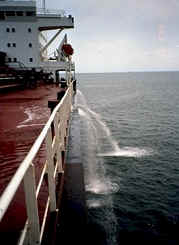 W
WBallast water discharges by ships can have a negative impact on the marine environment. The discharge of ballast water and sediments by ships is governed globally under the Ballast Water Management Convention, since its entry into force in September 2017. It is also controlled through national regulations, which may be separate from the Convention, such as in the United States.
 W
WThe Convention for the Protection of the Marine Environment and the Coastal Region of the Mediterranean, originally the Convention for Protection of the Mediterranean Sea against Pollution, and often simply referred to as the Barcelona Convention, is a regional convention adopted in 1976 to prevent and abate pollution from ships, aircraft and land based sources in the Mediterranean Sea. This includes but is not limited to dumping, run-off and discharges. Signers agreed to cooperate and assist in dealing with pollution emergencies, monitoring and scientific research. The convention was adopted on 16 February 1976 and amended on 10 June 1995.
 W
WThe Clean Boating Act of 2008 (CBA) is a United States law that requires recreational vessels to implement best management practices to control pollution discharges. The law exempts these vessels from requirements to obtain a discharge permit under the Clean Water Act.
 W
WThe Coal Oil Point seep field (COP) in the Santa Barbara Channel offshore from Goleta, California, is a marine petroleum seep area of about three square kilometres, within the Offshore South Ellwood Oil Field and stretching from the coastline southward more than three kilometers (1.9 mi). Major seeps are located in water depths from 20 to 80 meters. The seep field is among the largest and best studied areas of active marine seepage in the world. These perennial and continuous oil and gas seeps have been active on the northern edge of the Santa Barbara Channel for at least 500,000 years. The combined seeps in the field release about 40 tons of methane per day and about 19 tons of reactive organic gas ; about twice the hydrocarbon air pollution released by all the cars and trucks in Santa Barbara County in 1990. The liquid petroleum produces a slick that is many kilometres long and when degraded by evaporation and weathering, produces tar balls which wash up on the beaches for miles around.
 W
WCruise ship pollution in Europe is a major part of the environmental impact of shipping. Most cruise ship companies operating in European exclusive economic zones (EEZs) are part of two megacorporations: Carnival Corporation & plc and the Royal Caribbean Group. In 2017, Carnival's cruise ships alone caused ten times more air pollution than all of Europe's cars (over 260 million) combined, as the ship fuel emits about 2,000 times more sulphur oxides (SOx) than normal diesel fuel. All cruise ships together also accounted for 15% of the nitrogen oxide (NOx) particles emitted by all of Europe's passenger vehicles, and released large amounts of carbon dioxide (CO2), phosphorus (P4), soot, heavy metals and other particulates into the atmosphere as well.
 W
WCruise ships carrying several thousand passengers and crew have been compared to “floating cities,” and the volume of wastes that they produce is comparably large, consisting of sewage; wastewater from sinks, showers, and galleys (graywater); hazardous wastes; solid waste; oily bilge water; ballast water; and air pollution. The waste streams generated by cruise ships are governed by a number of international protocols and U.S. domestic laws, regulations, and standards, but there is no single law or rule. Some cruise ship waste streams appear to be well regulated, such as solid wastes and bilge water. But there is overlap of some areas, and there are gaps in others.
 W
WDead zones are hypoxic (low-oxygen) areas in the world's oceans and large lakes, which causes these bodies of water to fail to support the marine life living there. Historically, many of these sites were naturally occurring. However, in the 1970s, oceanographers began noting increased instances and expanses of dead zones. These occur near inhabited coastlines, where aquatic life is most concentrated.
 W
WThe environmental impact of shipping includes air pollution, water pollution, acoustic, and oil pollution. Ships are responsible for more than 18 percent of some air pollutants.
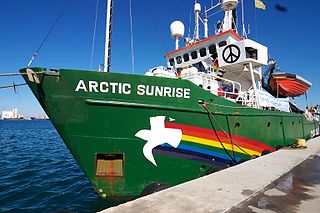 W
WAfter Greenpeace activists attempted to scale the Prirazlomnaya drilling platform on 18 September 2013, as part of a protest against Arctic oil production, Russian authorities seized the Greenpeace ship the Arctic Sunrise in international waters in the Russian Exclusive Economic Zone on 19 September 2013, arrested the crew at gunpoint, towed the ship to Murmansk, and detained the crew of 28 activists and two freelance journalists. The Investigative Committee of Russia opened a criminal investigation, charging the activists initially with piracy and later with hooliganism. Since the Arctic Sunrise was flying the Dutch flag, the Netherlands filed a case at the International Tribunal for the Law of the Sea and obtained an order for the release of the crew and ship pending a final adjudication of the matter. Russia ignored the ITLOS ruling, but eventually released the crew as part of a general amnesty adopted by the State Duma after two months of detention. The Arctic Sunrise itself was released in June 2014.
 W
WKids Ocean Day HK was organised by Ocean Recovery Alliance to celebrate Kids Ocean Day in Hong Kong.
 W
WThe Convention on the Prevention of Marine Pollution by Dumping of Wastes and Other Matter 1972, commonly called the "London Convention" or "LC '72" and also abbreviated as Marine Dumping, is an agreement to control pollution of the sea by dumping and to encourage regional agreements supplementary to the Convention. It covers the deliberate disposal at sea of wastes or other matter from vessels, aircraft, and platforms. It does not cover discharges from land-based sources such as pipes and outfalls, wastes generated incidental to normal operation of vessels, or placement of materials for purposes other than mere disposal, providing such disposal is not contrary to aims of the Convention. It entered into force in 1975. As of September 2016, there were 89 Parties to the Convention.
 W
WMarine Protection, Research and Sanctuaries Act of 1972 (MPRSA) or Ocean Dumping Act is one of several key environmental laws passed by the US Congress in 1972. The Act has two essential aims: to regulate intentional ocean disposal of materials, and to authorize any related research. While the MPRSA regulates the ocean dumping of waste and provides for a research program on ocean dumping, it also provides for the designation and regulation of marine sanctuaries. The act regulates the ocean dumping of all material beyond the territorial limit and prevents or strictly limits dumping material that "would adversely affect human health, welfare, or amenities, or the marine environment, ecological systems, or economic potentialities". The MPRSA authorized the Environmental Protection Agency (EPA) to regulate ocean dumping of materials including, but not limited to, industrial waste, sewage sludge, biological agents, radioactive agents, NBC, garbage, chemicals, and biological and laboratory, as well as other wastes, into the territorial waters of the United States through a permit program. The EPA can issue permits for dumping of materials other than dredge spoils if the agency determines, through a full public notice and process, that the discharge will not unreasonably degrade or endanger human health or welfare or the marine environment. The law also has provisions related to creating marine sanctuaries, conducting ocean disposal research and monitoring coastal water quality.
 W
WThe Mega Borg oil spill occurred in the Gulf of Mexico on June 8, 1990, roughly 50 miles off the coast of Texas, when the oil tanker Mega Borg caught on fire and exploded. The cleanup was one of the first practical uses of bioremediation.
 W
WThe Merchant Shipping (Pollution) Act 2006 is an Act of the Parliament of the United Kingdom. It has three main purposes: to give effect to the Supplementary Fund Protocol 2003, to give effect to Annex IV of the MARPOL Convention, and to amend section 178(1) of the Merchant Shipping Act 1995.
 W
WMercury is a toxic heavy metal which cycles through the atmosphere, water and soil in various forms to different parts of the world. Due to this natural cycle, irrespective of which part of the world releases mercury it could affect an entirely different part of the world making mercury pollution a global concern. Mercury pollution is now identified as a global problem and awareness has been raised on an international action plan to minimize anthropogenic mercury emissions and clean up mercury pollution. The 2002 Global Mercury Assessment concluded that "International actions to address the global mercury problem should not be delayed”. Among many environments that are under the impact of mercury pollution, the ocean is one which cannot be neglected as it has the ability to act as a “storage closet” for mercury. According to a recent model study the total anthropogenic mercury released into the ocean is estimated to be around 80,000 to 45,000 metric tons and two thirds of this amount is estimated to be found in waters shallower than 1000m level where many consumable fish live. Mercury can get bio-accumulated in marine food chains in the form of highly toxic methyl mercury which can cause health risks to human seafood consumers. According to statistics, about 66% of the global fish consumption comes from ocean. Therefore, it is important to monitor and regulate oceanic mercury levels to prevent more and more mercury reaching human population through seafood consumption.
 W
WOcean Recovery Alliance (ORA) is a 501c3 registered non-profit organization in California, and registered charitable organization in Hong Kong, with the aim to use new technologies, innovations, creativity and collaborations to solve issues that face the health of the ocean today.
 W
WOil Pollution Act of 1924 is a United States federal statute establishing regulations for coastal navigable waters with regards to intentional fossil fuel discharges from seagoing vessels. The Act of Congress grants the Secretary of War authority to evaluate the oil volume discharge from a vessel while assessing if coastal navigable waters have a potential toxicity posing a deleterious condition for human health and seafood contamination. The 1924 United States statute provides judicial penalties encompassing civil and criminal punishment for violations of the prescribed regulations as stated in the Act.
 W
WOil Pollution Act of 1961, 33 U.S.C. Chapter 20 §§ 1001-1011, established judicial definitions and coastal prohibitions for the United States maritime industry. The Act invoked the accords of the International Convention for the Prevention of the Pollution of the Sea by Oil, 1954. The international agreement provided provisions to control the discharge of fossil fuel pollutants from nautical vessels on the high seas.
 W
WThe Oil Pollution Act of 1973 or Oil Pollution Act Amendments of 1973, 33 U.S.C. Chapter 20 §§ 1001-1011, was a United States federal law which amended the United States Statute 75 Stat. 402. The Act of Congress sustained the United States commitment to control the discharge of fossil fuel pollutants from nautical vessels and to acknowledge the embargo of coastal zones in trans-boundary waters.
 W
WThe Oil Pollution Act of 1990 (OPA) was passed by the 101st United States Congress and signed by President George H. W. Bush. It works to avoid oil spills from vessels and facilities by enforcing removal of spilled oil and assigning liability for the cost of cleanup and damage; requires specific operating procedures; defines responsible parties and financial liability; implements processes for measuring damages; specifies damages for which violators are liable; and establishes a fund for damages, cleanup, and removal costs. This statute has resulted in instrumental changes in the oil production, transportation, and distribution industries.
 W
WAn oil spill is the release of a liquid petroleum hydrocarbon into the environment, especially the marine ecosystem, due to human activity, and is a form of pollution. The term is usually given to marine oil spills, where oil is released into the ocean or coastal waters, but spills may also occur on land. Oil spills may be due to releases of crude oil from tankers, offshore platforms, drilling rigs and wells, as well as spills of refined petroleum products and their by-products, heavier fuels used by large ships such as bunker fuel, or the spill of any oily refuse or waste oil.
 W
WOil toxicity is a wildlife disease resulting from the accidental exposure of animals to oil. Major sources of such oil in the environment include accidental oil spills from off-shore sites, oil tankers, pipelines, and other facilities that store and process oil. Wildlife exposure to oil can result in both external and internal damage. Oil intoxication has the greatest impact on bird species, aquatic mammals, and other aquatic organisms. Affected wildlife can usually be identified via visual inspection, and can be treated if found early on.
 W
WOperation CHASE was a United States Department of Defense program for the disposal of unwanted munitions at sea from May 1964 until the early 1970s. Munitions were loaded onto ships to be scuttled once they were at least 250 miles offshore. While most of the sinkings involved conventional weapons, four of them involved chemical weapons. The disposal site for the chemical weapons was a three-mile (5 km) area of the Atlantic Ocean between the coast of the U.S. state of Florida and the Bahamas. The CHASE program was preceded by the United States Army disposal of 8000 tons of mustard and lewisite chemical warfare gas aboard the scuttled SS William C. Ralston in April 1958. These ships were sunk by having Explosive Ordnance Demolition (EOD) teams open seacocks on the ship after they arrived at the disposal site. The typical Liberty ship sank about three hours after the seacocks were opened.
 W
WThe Convention for the Protection of the Marine Environment of the North-East Atlantic or OSPAR Convention is the current legislative instrument regulating international cooperation on environmental protection in the North-East Atlantic. Work carried out under the convention is managed by the OSPAR Commission, which is made up of representatives of the Governments of the 15 signatory nations, and representatives of the European Commission, representing the European Union.
 W
WPartnerships in Environmental Management for the Seas of East Asia or PEMSEA is a regional partnership programme implemented by the United Nations Development Programme (UNDP) and executed by the United Nations Office for Project Services (UNOPS). The project, started in 1994, was originally known as Prevention and Management of Marine Pollution in the East Asian Seas (SDS-SEA).
 W
WPlastic resin pellet pollution is a type of marine debris originating from plastic particles utilized in manufacturing large-scale plastics. These pre-production plastic pellets are created separately from the user plastics they are melted down to form, and pellet loss is incurred during both the manufacturing and transport stages. Commonly referred to as nurdles, these plastics are released into the open environment, creating pollution in the oceans and on beaches.
 W
WProject Kaisei is a scientific and commercial mission to study and clean up the Great Pacific Garbage Patch, a large body of floating debris trapped in the Pacific Ocean by the currents of the North Pacific Gyre. Discovered by NOAA, the patch is estimated to contain 20 times the density of floating debris compared to the global average. The project aims to study the extent and nature of the debris with a view to capturing, detoxifying, and recycling the material, and is organised by the Ocean Voyages Institute, a California-based 501c3 non-profit organisation dealing with marine preservation. The project is based in San Francisco and Hong Kong.
 W
WRainbowing is the process in which a dredging ship propels sand that has been claimed from the ocean floor in a high arc to a particular location. This is used for multiple purposes, ranging from building up a beach to prevent erosion to constructing new islands. The name is derived from the appearance of the arc, which closely resembles a brown-colored rainbow.
 W
WAfter delivering their cargo, empty commercial ships need to take up water from the port of arrival in order to maintain stability and ensure safe navigation conditions before heading back to the port of departure. This water, called ballast water, which contains aquatic organisms typical of the port of arrival, is stored in ballast tanks and is ultimately discharged at the port of departure when the ship is ready to be re-loaded. During this process, aquatic organisms capable of surviving in ballast water are released into new environments and can therefore become invasive species, causing serious economic and public health issues.
 W
WSea glass and beach glass are similar but come from different types of water. "Sea glass" is physically and chemically weathered glass found on beaches along bodies of salt water. These weathering processes produce natural frosted glass. "Genuine sea glass" can be collected as a hobby and is used for decoration, most commonly in jewelry. "Beach glass" comes from fresh water and in most cases has a different pH balance and a less frosted appearance than sea glass. Sea glass takes 20 to 40 years, and sometimes as much as 100 years, to acquire its characteristic texture and shape. It is also colloquially referred to as "drift glass" from the longshore drift process that forms the smooth edges. In practice, the two terms are used interchangeably.
 W
WSusan D. Shaw is an American environmental health scientist, explorer, ocean conservationist, and author. A Doctor of Public Health, she is a professor in the Department of Environmental Health Sciences at the School of Public Health at the State University of New York at Albany, and Founder/President of the Shaw Institute, a nonprofit scientific institution with a mission to improve human and ecological health through innovative science and strategic partnerships. Shaw is globally recognized for pioneering high-impact environmental research on ocean pollution, climate change, oil spills, and plastics that has fueled public policy over three decades. In 1983, with landscape photographer Ansel Adams, she published Overexposure, the first book to document the health hazards of photographic chemicals. Shaw is credited as the first scientist to show that brominated flame retardant chemicals used in consumer products have contaminated marine mammals and commercially important fish stocks in the northwest Atlantic Ocean. She became the first scientist to dive into the Gulf of Mexico oil slick following the 2010 BP Deepwater Horizon oil rig explosion to investigate the impacts of chemical dispersants used in response to the spill.
 W
WSurface runoff is the flow of water occurring on the ground surface when excess rainwater, stormwater, meltwater, or other sources, can no longer sufficiently rapidly infiltrate in the soil. This can occur when the soil is saturated by water to its full capacity, and that the rain arrives more quickly than the soil can absorb it. Surface runoff often occurs because impervious areas do not allow water to soak into the ground. Surface runoff is a major component of the water cycle. It is the primary agent of soil erosion by water. The land area producing runoff that drains to a common point is called a drainage basin.
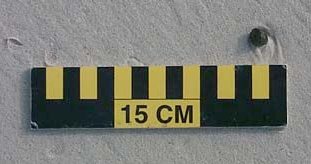 W
WA tarball is a blob of petroleum which has been weathered after floating in the ocean. Tarballs are an aquatic pollutant in most environments, although they can occur naturally and as such are not always associated with oil spills.
 W
WThe TerraMar Project, in the United States, was a self-described environmental nonprofit organization with a focus on ocean protection founded in 2012 by Ghislaine Maxwell. A separate ocean conservation charity, TerraMar (UK), was incorporated in 2013 by Maxwell in Salisbury, United Kingdom. The TerraMar Project was incorporated in London and Delaware in 2012. TerraMar (US) announced its closure on 12 July 2019, shortly after New York federal prosecutors arrested Maxwell's close associate, the financier and convicted sex offender Jeffrey Epstein, on new charges of sex trafficking. However, Maxwell's company TerraMar (UK) continued to exist with her listed as a director until it was officially dissolved on 3 December 2019.
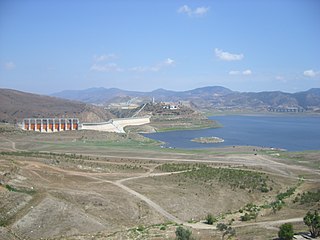 W
WThe Tijuana River is an intermittent river, 120 mi (195 km) long, near the Pacific coast of northern Baja California state in northwestern Mexico and Southern California in the western United States.
 W
WThe 2017 United Nations Ocean Conference was a United Nations conference that took place on June 5th-9th 2017 which sought to mobilize action for the conservation and sustainable use of the oceans, seas and marine resources.